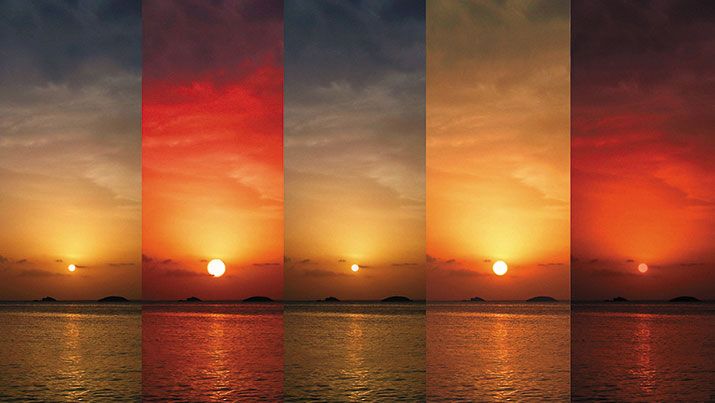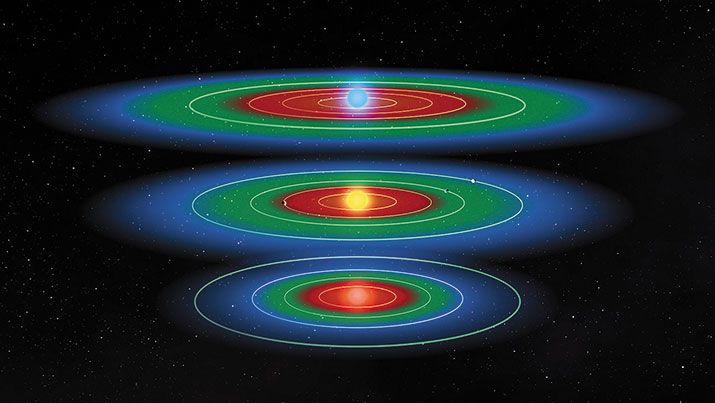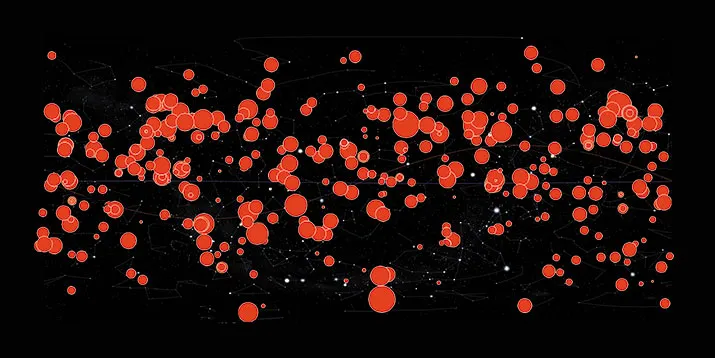Earth-Like Planets Could be Right Next Door
Astronomers estimate that billions of habitable planets are orbiting red dwarf stars. What would it be like to live there?
/https://tf-cmsv2-smithsonianmag-media.s3.amazonaws.com/filer/Planet-Nearby-Red-Dwarf-Star-6311.jpg)
Even in places where skies are dark and the Milky Way seems to fill our view, the night sky is teeming with stars we cannot see. These other stars, invisible to the naked eye, are red dwarfs—smaller, cooler, dimmer, and far, far more common in the galaxy than stars like our sun.
Only visible with telescopes, red dwarfs constitute about three-fourths of the hundreds of billions of stars in the Milky Way. Until this year, those billions of stars were generally overlooked by astronomers searching for another class of objects that can’t be seen with the naked eye: exoplanets. Now two recent studies have looked exclusively at red dwarf stars, and the estimates are in: More than 50 percent could harbor potentially habitable planets. That enormous probability leads to one more exciting conclusion: Another planet with life could be just a few light-years away. In a galaxy that’s 100,000 light-years across, that’s just down the block from Earth.
Given the challenges of taking a detailed look at a habitable planet orbiting a star like our sun—it will take a new generation of powerful and expensive telescopes, almost certainly in space, to study a small, rocky planet amid a yellow star’s glare—this huge population of red dwarfs offers immense opportunities for discovery. And a chance to open our imaginations to wildly different kinds of life in the universe.
“I think we have a natural tendency to always talk about things that are like what we know,” says Courtney Dressing, a graduate student with the Harvard-Smithsonian Center for Astrophysics in Cambridge, Massachusetts. Dressing and David Charbonneau, who focuses on finding and characterizing exoplanets, published the first of the two papers that estimated the prevalence of habitable planets orbiting red dwarfs. Their calculation came in on the low end; they believe around 15 percent of the red dwarfs are likely to have habitable planets in their thrall, a percentage that amounts to tens of billions of stars. The second study was conducted by Ravi kumar Kopparapu, an exoplanet researcher at Pennsylvania State University. By calculating a larger habitable zone, Kopparapu estimated as many 48 to 61 percent could potentially harbor life.
“We’ve come to realize that the universe is a pretty unusual place, so we don’t always have to find the exact same conditions [as Earth for habitability to be possible],” says Dressing. “We realize now that it’s important to look for potentially habitable planets around smaller types of stars as well.”
Red dwarfs are, on average, one-third the size and 1,000 times dimmer than the sun. For astronomers looking for exoplanets, the smaller size and dimness of red dwarfs mean a lot less glare that could conceal an orbiting planet. The difficulty of resolving detail on a planet near a star is particularly acute in the search for planets around red dwarfs, because astronomers estimate that the habitable zone—the region where it’s neither too hot nor too cold for liquid water to exist—around these cooler stars is much closer to the star than even Mercury is to the sun.
Armed with nearly two decades of exoplanet discoveries, astronomers have started to assemble a picture of what a habitable planet might look like, but most have focused on what we know: a planet like Earth orbiting a yellow dwarf star like our sun, classified as a G-type, main-sequence star. But what about the smaller, red M-type stars? What might your home be like if it were in red dwarf orbit? The answer is kind of like Earth, and a lot unlike Earth.
From the surface of this imaginary habitable planet, one of the first things we’d notice is that the sun is very big in the sky. It would appear one and a half to three times bigger than Earth’s sun, given the close orbit, says John Johnson, an exoplanet researcher and assistant professor at the California Institute of Technology in Pasadena. And, as you might infer from the name, this sun is going to appear extremely red, due to its cooler temperature. Red dwarfs are about half as hot as our sun.
So far, this planet on which we stand is a bit foreign compared to Earth, but not shockingly different. This is where any sense of familiarity ends, however, because another consequence of orbiting so close to its star is that the planet could be tidally locked, so that one side always faces its sun. Astronomers call this synchronous rotation, when an orbiting body takes the same time to rotate around its axis as it does to revolve around another body, just like our moon does as it orbits Earth.
Or it could be like Mercury, says Jim Kasting, an exoplanet researcher at Pennsylvania State University and the author of How to Find a Habitable Planet. Mercury, he explains, is caught in a “spin- orbit resonance” and rotates three times for every two orbits around the sun. This stable relationship between orbital and rotational periods is caused by the long shape, or eccentricity, of Mercury’s orbital path, which in turn is caused by the pull of gravity from the many outer planets—a situation that could also exist for a close-orbiting exoplanet. In other words, it’s possible that on our imaginary planet, we would enjoy only three sunrises every two years.
Let’s say our red dwarf planet is tidally locked. The common assumption is that one side of the planet, in eternal daylight, would be scorched while the side in perpetual night would be frozen solid. But that’s not necessarily true, says Kasting.
Astronomers working with Jill Tarter, the longtime champion of the search for extraterrestrial intelligence, have shown how tidally locked planets could support life. Tarter recently stepped down as director of the SETI Institute to lead the funding for the Allen Telescope Array in California (see “Can We Hear Them Now?” July 2007), which will spend time listening for extraterrestrial signals from red dwarf systems. For many years, says Seth Shostak, a senior astronomer at the SETI Institute, astronomers had ruled out red dwarfs as places to look for Earth-like planets because they believed that being tidally locked would make them uninhabitable. Tarter, among the first to seriously address whether red dwarfs could harbor planets viable for life, convened a workshop to consider the idea, publishing their conclusions in the journal Astrobiology in 2007.
Studies at the time suggested that on a planet with a substantial enough atmosphere, the climate would be dominated by currents that pull up water in the air and toward the surface in oceans on the hotter, day side—a process called upwelling. This circulation would result in thick clouds covering the sun-facing side; the clouds would prevent the persistent solar radiation from scorching the surface. The currents would also cause atmospheric churning that would spread warmth around the planet.
Furthermore, this thickening of the atmosphere on the dayside would provide an important defense against other radiation dangers as well. Young red dwarfs, in their first few billion years, tend to be very active, emitting flares and ultraviolet radiation. Tarter and her colleagues proposed that the constant cloud cover would help diffuse these violent outbursts—though not totally. Indeed, life on a planet orbiting a young red dwarf might be more likely found underwater, taking advantage of even more protective layers.
On some planets orbiting red dwarfs, a search for “hidden” water, like the one that has dominated NASA’s exploration of Mars, won’t be necessary. The nature of planet formation in these systems could result in some habitable planets being covered in water. One reason, says Kasting, is that Earth-size planets residing in the close-in habitable zone probably formed farther out and migrated inward.
Planets form in a star’s debris disk by sweeping up dust and ice particles in their orbits. A planet with a small orbit generally won’t be able to collect as many particles as one in a longer orbit, so it won’t grow as large (just look at Mercury and Venus, for example, both smaller than Earth). Additionally, the closer a planet is to the star, the stronger the star’s gravitational pull is on the planet, and the faster the planet has to travel to keep from getting pulled in. This speed leads to a violent early life. Frequent collisions with other large objects can strip away a young planet’s atmosphere, or keep a sizable planet from forming altogether.
Planets that form farther out might gather up an excess of ice and, once they shimmy into the habitable zone, essentially become water worlds. “Earth’s oceans are an average of three kilometers deep if you spread them out over entire surface, but you might have an ocean [on an exoplanet] that’s 300 kilometers deep,” Kasting says. “That might be okay for marine life, but it probably would preclude the presence of continents.” Any visitors are going to need a raincoat in addition to a boat, because the planet’s highly active water cycle, Tarter writes, would produce “intense cloudiness, as well as massive precipitation.”
If, however, there’s enough water for a cloudy sky and sizable oceans, and currents strong enough to distribute heat, you could very well see our imagined exoplanet having forested continents. But even here things can get a little strange. Nancy Kiang at NASA’s Goddard Institute for Space Studies in New York has investigated the color plants might have on a habitable planet orbiting red dwarf stars, and the answer is not green.
Earth plants survive by converting the light our sun gives off into energy through photosynthesis. In most plants, the chlorophyll that enables this process absorbs blue and red light while reflecting the green light. But a red dwarf radiates much less visible light than our sun. A plant on this red dwarf planet might need to absorb as many wavelengths of light as possible to maximize photosynthesis. The plants, reflecting back almost no visible light, would appear black.
In fact, all the life on our imaginary planet might not just look different because of its red dwarf sun, it could be much, much older. Red dwarfs can exist for hundreds of billions of years before they finish the slow depletion of their fuel—indeed, they live for so long that it’s likely no red dwarf that has come into existence since the beginning of the universe has died.
For comparison, our sun is about halfway through its 10-billion-year lifespan; the simplest life on Earth developed about 3.8 billion years ago, and Homo sapiens barely more than 100,000 years ago. A red dwarf that was among the first stars that formed, nearly 13 billion years ago, could still be around today, and could theoretically be hosting a planet where life has existed for twice, maybe even three times as long as single-cell bacteria have existed on Earth.
“I’m very confident that within my lifetime—I’m 35 now—we will be able to find biosignatures of potentially habitable planets,” says Penn State’s Ravi kumar Kopparapu. His reported estimate, that as many as 61 percent of red dwarfs might have habitable planets, came from information about Venus and Mars extrapolated from our solar system’s history—that is, when water was still present on Venus before it evaporated and when the ice on Mars was liquid. Kopparapu calculated the sun’s brightness on each planet during these times and compared it to the brightness of red dwarfs. When he used this data to put limits on a habitable zone, he found it was larger than the zone Dressing used for her estimate.
Johnson, from Caltech, says speculating about what it’s like on a habitable planet orbiting a red dwarf is clearly an exercise that has just begun. “As for what’s [actually] going on on the surface of those planets, we don’t have the slightest clue, to be honest,” he says. Johnson said he’s still blown away by the thought that rocky, potentially habitable exoplanets are common. “I haven’t gotten used to that yet,” he says. “It’s not hunting anymore; it’s gathering. You just reach up into the sky and grab these things. They’re sitting right next door.”
“I would say it’s the golden age of exoplanet studies,” says Kopparapu. “The best studies are ahead, if we can get together and get missions going. Do we really want to know if we’re alone? I think we can find out, if we’re committed to it.”
Bruce Lieberman is a freelance science writer in Carlsbad, California. He writes about astrophysics, climate change, and other subjects.
/https://tf-cmsv2-smithsonianmag-media.s3.amazonaws.com/accounts/headshot/Bruce_Lieberman_Yosemite_Cropped.jpg.jpeg)



/https://tf-cmsv2-smithsonianmag-media.s3.amazonaws.com/accounts/headshot/Bruce_Lieberman_Yosemite_Cropped.jpg.jpeg)